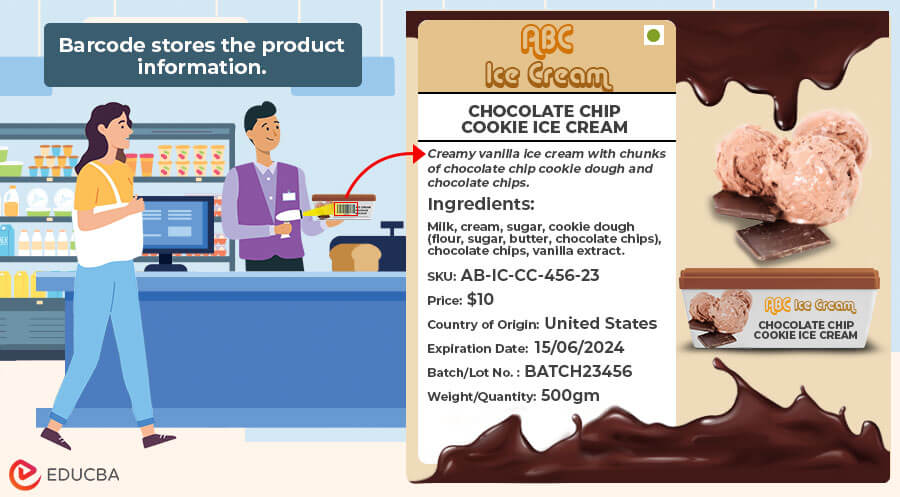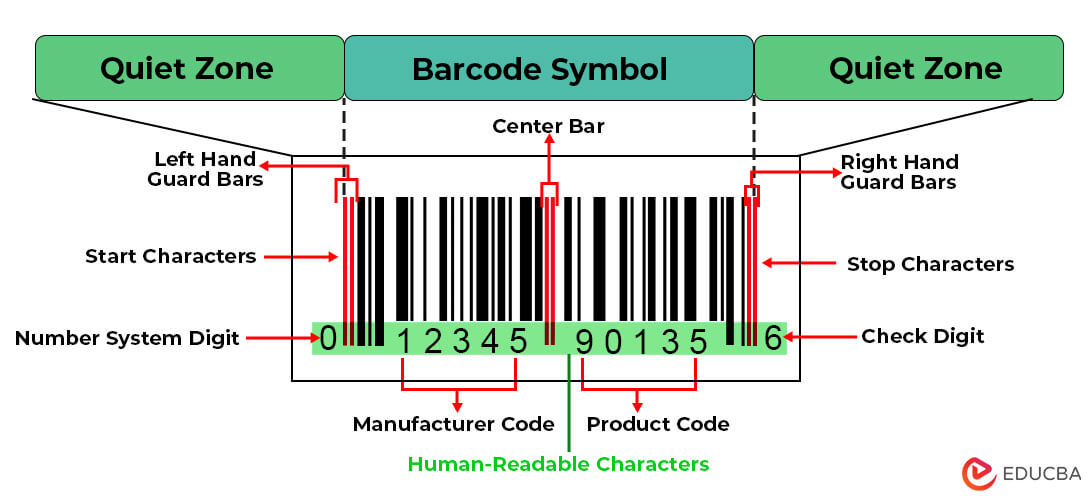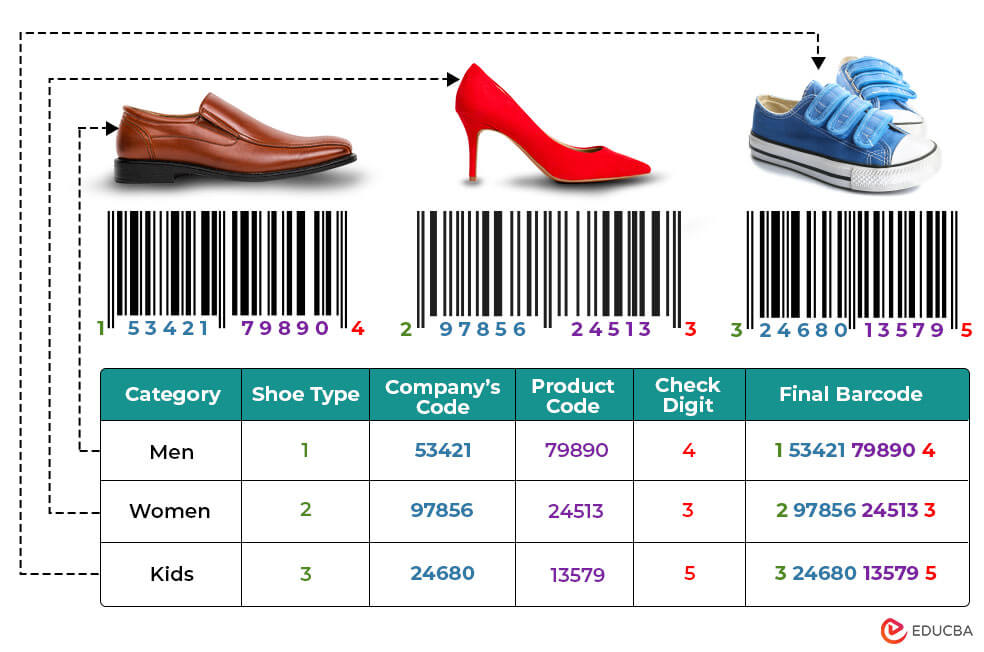What is Barcode?
A barcode is a readable code of a product that consists of vertical black and white bars of different widths. Machines can read this code and retrieve the product information.
These codes play a crucial role in retail transactions by storing product details such as manufacturing year, origin country, price, etc. They are also useful in warehouses for inventory management, product tracking, accounting, marketing, increasing productivity and efficiency.
Table of Contents
Components
The following are the details of the components in the barcode and their purpose.
| Components | Position | Purposes |
| Quiet Zone | Empty space before the start and after the end of the barcode. | Necessary for accurate scanning. |
| Start & Stop Characters | Beginning and end of the barcode. | Marks the start and end of the barcode, helping the scanner in accurate decoding. |
| Left Hand Guard Bars | Left side of the barcode. | Serve as the starting reference of the barcode for the scanner. |
| Number System Digit | Next to the left guard bar. | Indicates the type of information (e.g., manufacturer, product type, country of origin) |
| Manufacturer Code | Next to the number system digit. | Holds a unique identification number assigned by the Uniform Code Council to the manufacturer or company. It helps to distinguish different manufacturers. |
| Center Bar | Middle of the barcode. | Serves as a reference point for separating the manufacturer code from product code. |
| Product Code | Next to the center bar. | Identifies the specific product of the manufacturer. |
| Right Hand Guard Bars | On the right side of the barcode. | Assist the scanner in recognizing the end point of the barcode. |
| Check Digit | Present at the extreme right side. | Verifies accuracy in scanning, decoding, and detecting errors. |
| Human-Readable Characters | Below the code. | Provides a visual reference number for the encoded information, readable by humans. |
How Does it Work?
Manufacturers present the product information, like its type, manufacturer, and more, in a pattern of black bars and white spaces, known as barcodes. It encodes information using varying lengths of black lines and spaces between them. The black bars represent numbers 0 or 1, and the sequence signifies numbers 0 to 9.
A barcode system comprises several essential components, such as barcodes, printers, scanners, and barcoding software. The manufacturer uses this barcode system to create barcodes for their products. They first print this code from the barcode printer as a square or rectangle label or image and put it on products. When scanning a product, a barcode scanner or reader emits light onto the code, reading the line patterns from left to right. This scanner translates the code information into a computer-readable format, usually converting it into binary code (0 or 1) since computers only understand data in binary form.
The scanner connects to a computer with an installed Point of Sale (POS) system, which holds all information linked to each unique barcode. The decoded data is now displayed on the computer screen, providing details related to the scanned barcode.
Types
There are mainly two types: linear – or 1 Dimensional and 2 Dimensional.
#1: One-dimensional (1D)
One-dimensional is a linear barcode consisting only of lines with varying widths and spaces between them. This type can hold limited text information and is scanned horizontally with optical laser scanners.
The commonly used 1D barcodes are as follows:
➔ UPC (Universal Product Code)
The UPC is used primarily as a standardized barcode for retail products, warehouses, and distribution in the United States. It consists of lines with different widths and contains digits in numerical form, a min. of 6 digits as in UPC-E type, and a max. of 12 digits as in UPC-A type.
➔ EAN (European Article Number)
The EAN is similar to the UPC but is widely used in Europe and internationally. They are mostly used to label consumer goods for POS scanning and can store large amounts of data. The code comprises max. 13 digits (EAN-13), which holds large amounts of data, and min. 8 digits code (EAN-8), ideal for small products with limited space.
➔ CODE 39 (Code 3 of 9)
Code 39 is the oldest barcode consisting of numbers, letters, and symbols. The code length varies and is limited to the size of the label. It is useful in non-retail industries like automotive, electronics, and the U.S. Department of Defense.
➔ CODE 128
This high-density barcode encodes the 128-character set of the American Standard Code for Information Exchange (ASCII), including numbers, letters, and special characters. This Code 128 stores large amounts of data and is vital in various industries like factory automation, logistics, transportation, and supply chain operations, such as ordering, shipping, packaging, and distribution.
➔ ITF (Interleaved 2 of 5)
Interleaved 2 of 5 consists of only numbers and no letters of varying lengths, and the total number of digits must be even. It encodes data in pairs of numbers, meaning every 2 digits create one symbol, and is standardized under ISO/IEC 16390. It is applicable in the warehouse, distribution, and packaging industry for labeling cartons across the globe.
➔ Codaba
Codabar is often useful in education, libraries, healthcare, blood banks, Federal Express, and the shipping industry. It encodes up to 16 different characters (-$:/.+) and is known for its simplicity and ability to read in various conditions.
#2: Two-dimensional (2D)
A two-dimensional barcode is more complex and includes more information like web address, image, quantity, etc, in the form of a grid of pixels with fixed width and height. They are scanned horizontally and vertically with devices like smartphones or imager scanners containing cameras.
➔ QR (Quick Response) Code
This 2D code adheres to ISO/IEC 18004 standards and consists of black squares arranged on a white square grid. It can store large amounts of data such as text, URLs, contact information, or other data within a maximum limit of 7089 characters. QR codes are commonly useful in marketing, advertising, public transport, package delivery, magazines, and mobile payments.
➔ Data Matrix Code
Data Matrix code consists of black and white squares arranged in a rectangular or square pattern. Here, its unique identity lies in an L-shaped border and alternating patterns of rows and columns. This code stores large data up to 3116 characters, including files. Its common usage is in automotive, aerospace, healthcare, logistics, and electronics. The ISO/IEC certification number is ISO/IEC 16022. This code has error-checking capabilities, allowing scanners to read damaged codes effectively.
➔ PDF417
Stacks of multiple linear barcodes with varying widths create the PDF417 code. It stores variable-length characters holding up to 1.1 KB of data, encoding text, numbers, and binary data. It is also the standard of the USPS (United States Postal Service for Postage and the Department of Homeland Security for licenses and state-issued identification cards. Its widespread application also includes logistics, fingerprints, photographs, and signatures. PDF417 adheres to the ISO/IEC 15438 standard.
Example
Consider a scenario where Mr. Anderson wants to open a shoe shop in his locality. He wants to implement a simple system for shoe organization and efficient operation management. He plans to assign a unique barcode to each shoe in the shop. Let’s help Mr. Anderson generate a simple barcode according to the UPC-A guidelines.
Solution:
Let’s sort shoes into the following category:
1. Shoe Type: The first digits should represent the product type, as shown below.
- “1” for Men
- “2” for Women
- “3” for Kids
2. Manufacturer Code: Let’s categorize shoes by assigning 5-digit codes unique to each manufacturer. Each manufacturer has their unique code posted by UCC.
- “53421” for Men’s shoes from “Step-Up Footwear” company.
- “97856 ” for Women’s shoes from “Evergreen Sole” company.
- “24680” for kids’ shoes from “Urban Trend Shoe Co.” company
3. Shoe Model No.: Now, we will assign a 5-digit unique code assign by the company to each of their product, such as:
- “79890” for “Classic Loafer” ( Assigned by “Step-Up Footwear” for Classic Loafer, color-brown, and size-9)
- “24513” for “Stiletto” (Assigned by “Evergreen Sole” for Stiletto, color-red, and size-7)
- “13579” for “Sneaker” (Assigned by Urban Trend Co. for boy’s sneaker, color-blue, and size-2).
4. Check Digit: It is a number based on the barcode digits assigned and calculated by the software system to ensure the accuracy of the UPC. The check digits for the below barcode are as follows:
- “4” for “1 54321 67890”
- “3” for “2 98765 24680”
- “5” for “3 24680 13579”
This system will help Anderson in tracking products and managing inventory.
The image below shows the barcode of different shoes.
Benefits
The following are the benefits of using barcodes
➔ Enhanced Accuracy
If barcodes connect with your computer or POS system, it reduces manual data entry time. It enables reliable and accurate data entry, minimizes manual errors, and increases operational efficiency with fewer transaction mistakes.
➔ Increased speed
They are a safer and smarter way to process data related to shipment or trading items. The processing speed involved in managing bulk shipments in real time becomes faster. It also speeds up processes during checkout in retail stores.
➔ Inventory Management
It facilitates real-time tracking of inventory levels, allowing businesses to maintain optimal stock levels by tracking overstocking or understocking. It gives information about the trends in consumer habits and products in demand and helps adjust prices to boost profitability.
➔ Easy to Implement
Investing in a barcode system is a cost-saving method as it is easy to install and suitable for businesses of various sizes. It reduces labor costs, saves time, and reduces errors.
➔ Traceability and Security
It is a crucial tool in supply chain management. They provide unique identifiers for products, allowing the tracking of products throughout the supply chain, helping with authenticity verification, and improving security.
Recommended Articles
We hope this article on “What is Barcode” was informative and helpful to you. To learn more, refer to the following related articles.





